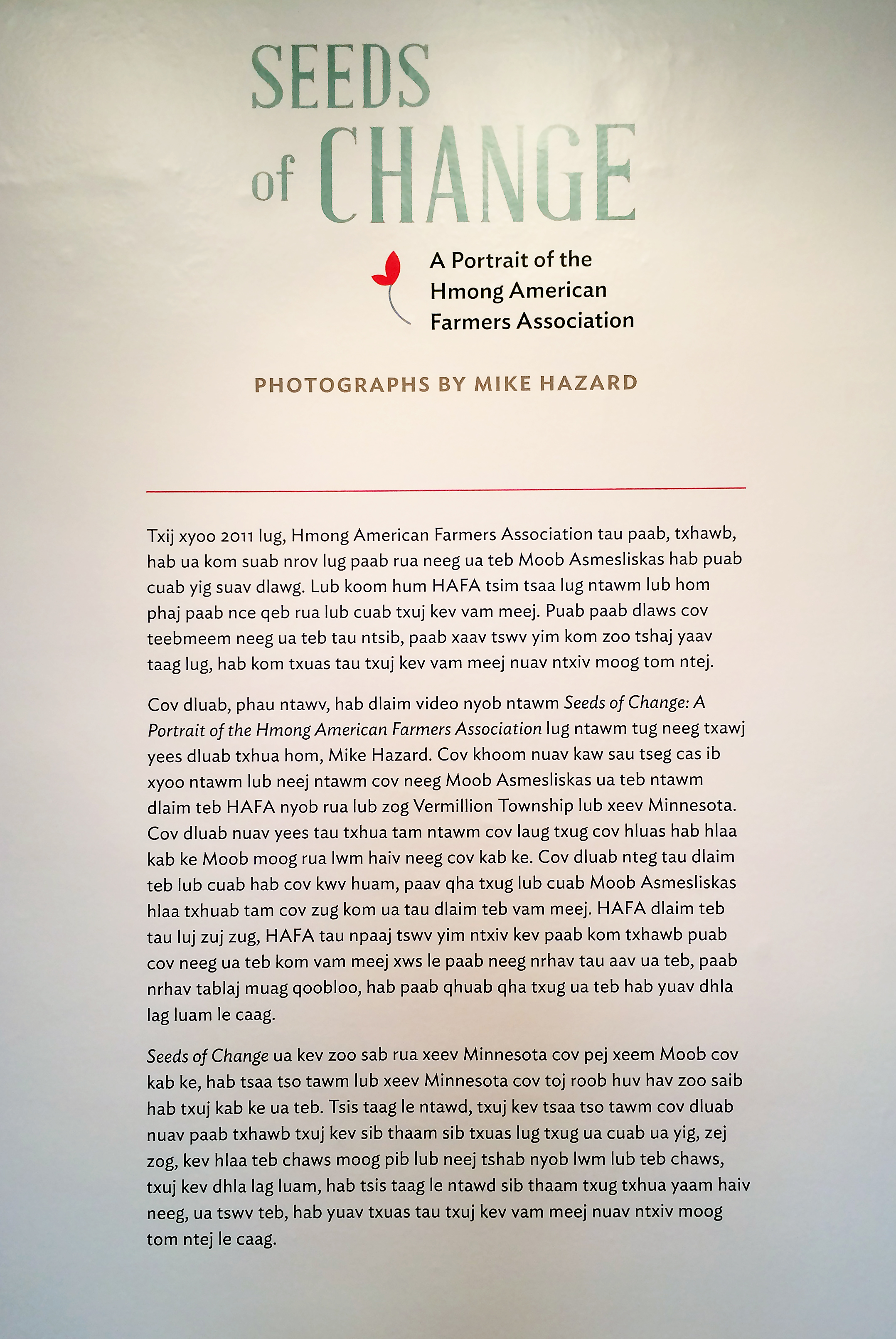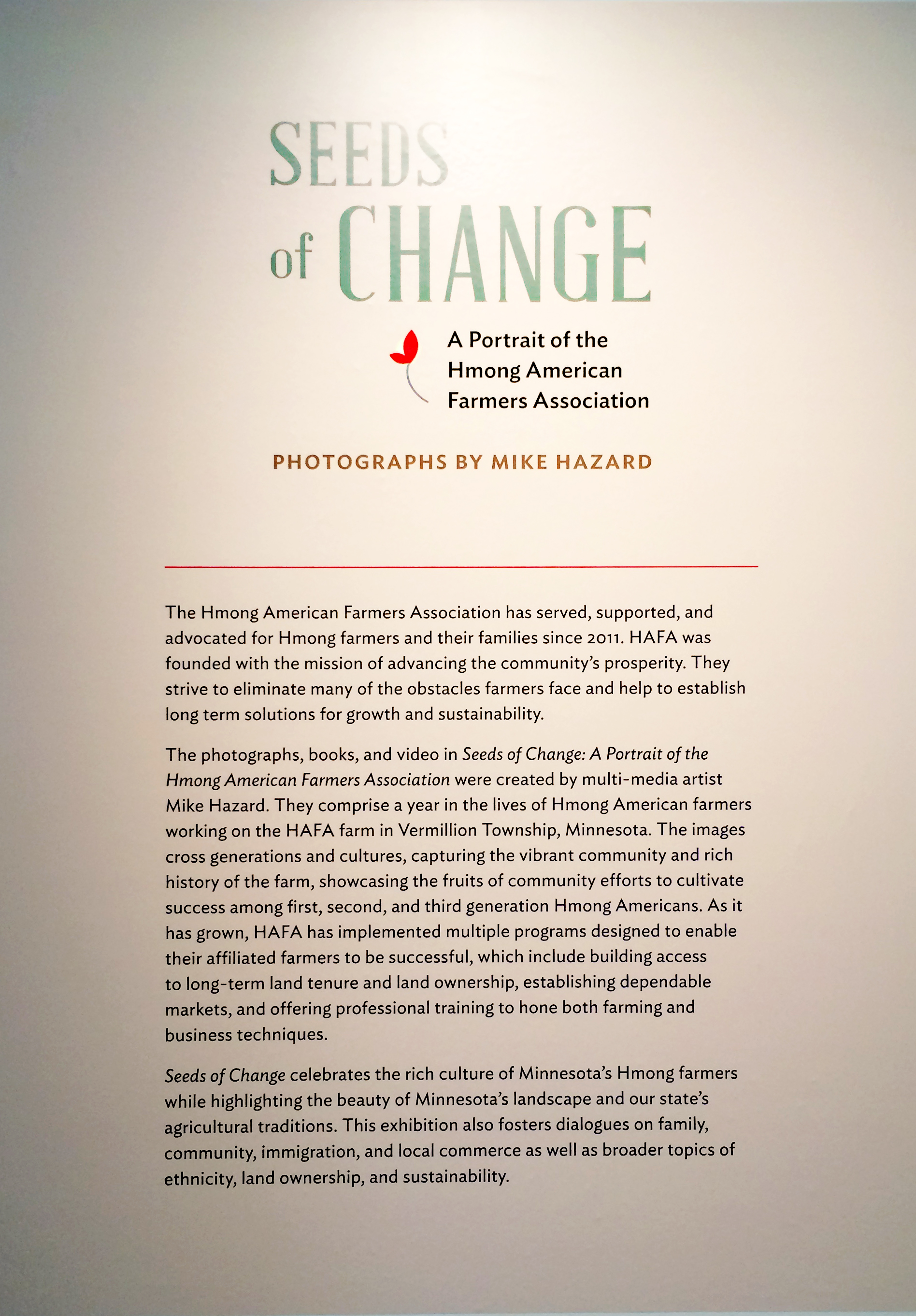A Gallery Reflection: Seeds of Change
Seeds of Change: A Portrait of the Hmong American Farmers Association
May 12 – July 31, 2016
http://www.mmaa.org/pages/SeedsofChange
Seeds of Change is an exhibition which showcases Mike Hazard’s photography and a video clip of the landscape in which the Hmong American Farmers Association (HAFA) worked. This exhibition was co-presented with HAFA documenting a farm for one year. I was particularly interested in how the artist showcases change, community and family dialogue.
I first heard about HAFA when I met Pakou Hang (the co-founder of HAFA) about three years ago. She was the keynote speaker at a small Hmong conference at the University of Wisconsin-Milwaukee. Hang highlighted her experiences with the politics of race, campaigning, advocating for Hmong representation and activism in the larger Minnesota communities.
I don’t remember specifics from her speech, however I do remember the power that came across her voice as she briefly spoke about being the campaign manager for former Minnesota State Senator Mee Moua, her involvement in the Chai Vang case-fighting for a fair trial, and supporting Hmong farmers who were experiencing unfair food systems in Minnesota. In which Hmong farmers were being charged unfair prices for land and white landowners demanding a percentage of all produced sold at local markets in the Twin Cities.
The Minnesota Museum of American Art (MMAA) describes Seeds of Change in the English gallery didactic:
“The images cross generations and cultures, capturing the vibrant community and rich history of the farm, showcasing the fruits of community efforts to cultivate success among first, second and third generation Hmong Americans.”
“...Celebrates the rich culture of Minnesota's Hmong farmers while highlighting the beauty of Minnesota's landscape and the state's agricultural traditions.”
“This exhibition also fosters dialogues on family, community, immigration, and local commerce as well as broader topics of ethnicity, land ownership, and sustainability.”
Walking into Seeds of Change with general knowledge of the struggle that HAFA and other Hmong farmers had experienced, I paid closer attention to the photographs shown on these walls. While observing each photograph I asked myself, is this really a portrait of the Hmong American Farmers Association?
There was nothing offensive about what was on display, I felt a bit unsettled at how utopic these landscapes and portraits looked. Many of the figures appear to be happy and enjoying their time, in their farming gear, holding plants, plowing the land etc. In several of the photographs stood young and old working together in the fields. A photo in particular captured youths learning about where food comes from, an important dialogue that is often missing in the conversation of food and nutrition, the farm to table experience that many people of color in America and of lower income communities cannot afford.
Frankly I did not get a strong sense of family dialogue from these photos as there was a stronger sense of showcasing the Minnesota agricultural landscapes and the Hmong farmers were a plus. As an artist exploring the Hmong American experiences, I explore family differently as I believe it is directly related to traditional gender roles and patriarchy.
I too grew up gardening. My family farmed ginseng in Wausau, Wisconsin for many years. I was more interested in the conversations that happen on these fields, the conversations that lead up to building a sustainable business in cultivating agricultural traditions in farming and the fight to occupy space in the food system.
I was hoping to see more than photographs of pretty landscapes, beautiful lighting on seeds, flowers and other plants. Mike Hazard's photos were all archival pigment prints, the images were glossy, and high in chrome. These were photos that one would be able to find in magazines such as the National Geographic, they felt like an outsider looking into the agricultural landscape of Minnesota, images that were chosen through the lens of Mike Hazard, the figures appear to only be living on the landscape. The figures were not captured beyond the farm and it left me questioning what their lives were beyond the farm as the everyday individual.
Since I was not able to attend this exhibition's opening reception, I'm left pondering what the artist intent was. Was this exhibition a collaboration between the artist and the Hmong American Farmers Association? Was this exhibition “A Portrait of the Hmong American Farmers Association”?
I don't think Mike Hazard successfully emulated a portrait of HAFA. According to the information in MMAA's website, the artist observed the farm and HAFA for one year, many things can happen in one year and yet all we see on the walls are tranquil landscapes. I was hoping to see how much HAFA's hard work and labor has on Minnesota's communities, from farm to table to farmers markets. Nevertheless still a portrait of Hmong American experiences, however from an outsider's perspective. These photos hardly scratched the surface of representation and how immigrant communities sculpt the landscape in Minnesota.
To find out more about The Hmong American Farmers Association please visit their website:
http://www.hmongfarmers.com/

